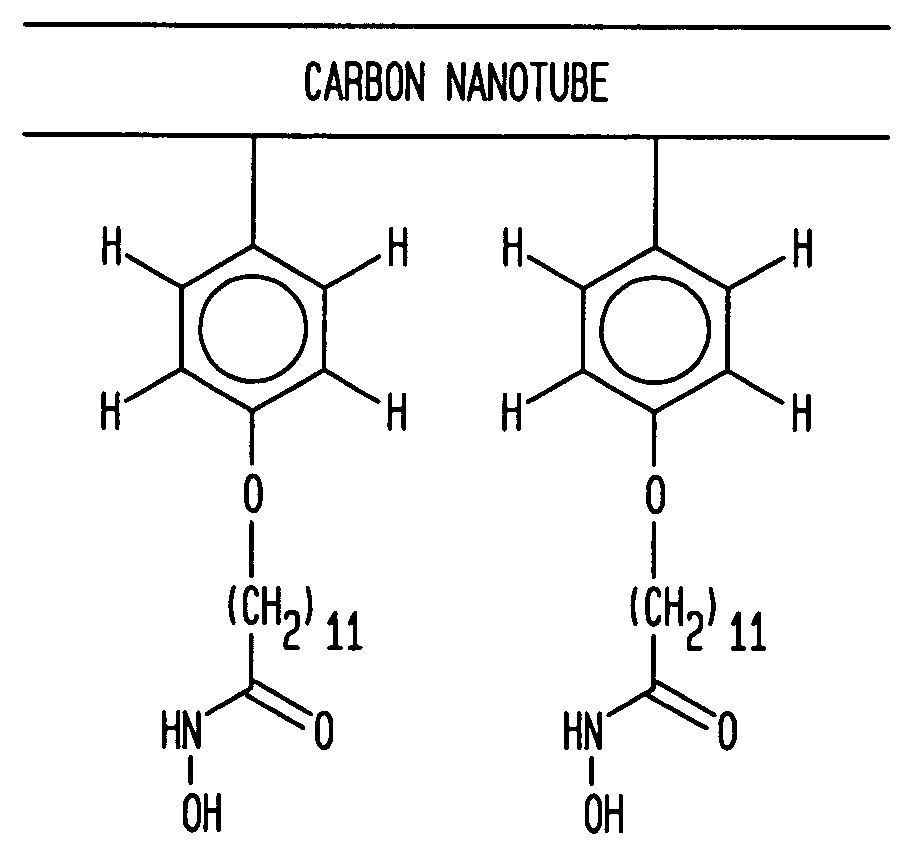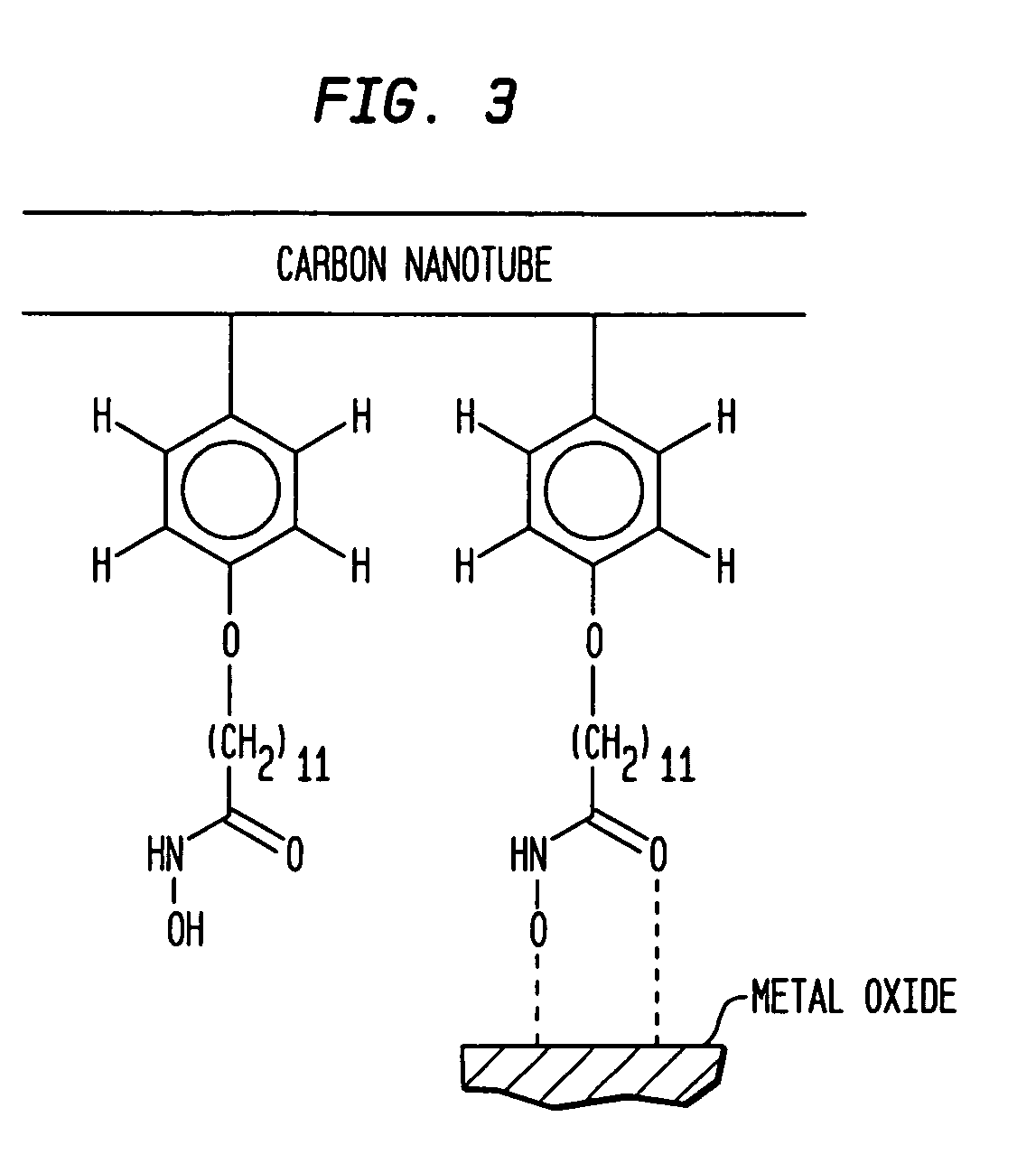Selective placement of carbon nanotubes through functionalization
a carbon nanotube and functionalization technology, applied in the direction of carbon-silicon compound conductors, coatings, chemistry apparatus and processes, etc., can solve the problems of inability to print apts using conventional poly(, dimethylsiloxane) (pdms) stamps, apts undergoes polymerization in solution, self-assembly must be carried out under controlled conditions, etc., to achieve little or no impact on physical and electrical properties, little or
- Summary
- Abstract
- Description
- Claims
- Application Information
AI Technical Summary
Benefits of technology
Problems solved by technology
Method used
Image
Examples
example 1
Preparation of a Bifunctional Organic Compound with a Hydroxamic Acid Functional Moiety and a Diazonium Functional Moiety
[0076]FIG. 9 shows the synthetic scheme for preparation of a bifunctional compound that comprises a hydroxamic acid moiety and a diazonium moiety. First, 11-bromo-1-undecanoic acid (9a) is converted to corresponding acid chloride (9b), which is then reacted with O-benzylhydroxylamine to form O-benzyl-10-bromodecylhydroxamic acid (9c). Reaction of 9c with 4-nitrophenol in the presence of potassium carbonate results in the formation of O-benzyl-10-(4-nitrophenoxy)decylhydroxamic acid (9d). Hydrogenation of 9d forms 10-(4-aminophenoxy)decylhydroxamic acid (9e), which reacts with nitrosonium tetrafluoroborate in acetonitrile to form the compound 9f, which contains a diazonium salt moiety at one end and a hydroxamic acid moiety at the other end.
[0077]In a specific experiment, oxallyl chloride (0.02 mole) was added to a solution of 0.01 mole 10-bromo-1-decanoic acid (9a...
example 2
Preparation of a Bifunctional Organic Compound with a Phosphonic Acid Functional Moiety and a Diazonium Functional Moiety
[0080]FIG. 10 shows the synthetic scheme for preparation of a bifunctional compound that comprises a phosphonic acid moiety and a diazonium moiety. First, 11-Bromo-1-undecanol (10a) is esterified with acetyl chloride and then reacted with triethylphosphite to form the phosphonate (10c). Deprotection of acetyl group and reaction of 4-nitrophenol in the presence of triphenyl phosphine and diethyl azodicarboxylate results in the formation of 11-nitrophenoxyundecyl phosphonate (10d). Reduction of nitro group to amine and hydrolysis of phosphonate to phosphonic acid then form O-benzyl 11-(4-nitrophenoxy)undecylphosphonic acid (10e). Hydrogenation of 10e can then form 11-(4-aminophenoxy)undecylhydroxamic acid (not shown), which in turn reacts with nitrosonium tetrafluoroborate in acetonitrile to form a compound (not shown) that contains a diazonium salt moiety at one en...
example 4
Selective Bonding of Functionalized Carbon Nanotubes to Substrate Surface with Metal Oxide
[0083]A SiO2 substrate patterned with Al2O3 was first formed, by first depositing a patterned Al film over the substrate, followed by oxidizing the Al film using an oxygen plasma. The patterned Al2O3 layer was about 4 nm thick. The substrate was then immersed in a dispersion of functionalized carbon nanotubes in methanol, as described in EXAMPLE 3, and heated to 50° C. The substrate was subsequently removed from the dispersion and sonicated in clean methanol, followed by drying in a stream of nitrogen. A deposition of functionalized carbon nanotubes exclusively on aluminum oxide surface was resulted.
PUM
| Property | Measurement | Unit |
|---|---|---|
| thickness | aaaaa | aaaaa |
| temperature | aaaaa | aaaaa |
| length | aaaaa | aaaaa |
Abstract
Description
Claims
Application Information
 Login to View More
Login to View More - R&D
- Intellectual Property
- Life Sciences
- Materials
- Tech Scout
- Unparalleled Data Quality
- Higher Quality Content
- 60% Fewer Hallucinations
Browse by: Latest US Patents, China's latest patents, Technical Efficacy Thesaurus, Application Domain, Technology Topic, Popular Technical Reports.
© 2025 PatSnap. All rights reserved.Legal|Privacy policy|Modern Slavery Act Transparency Statement|Sitemap|About US| Contact US: help@patsnap.com



